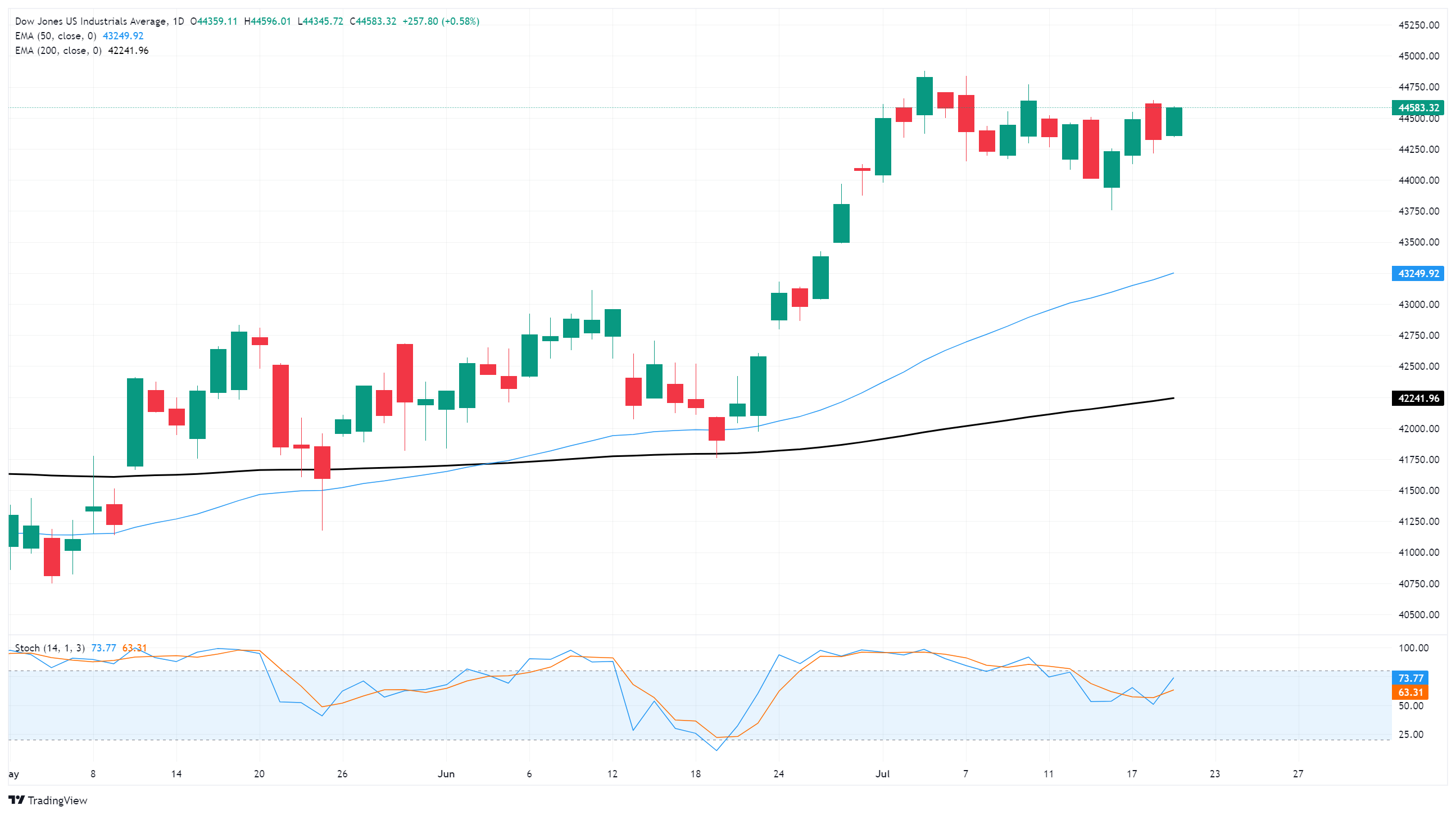Created
: 2025.07.22














![]() 2025.07.22 02:37
2025.07.22 02:37
The Dow Jones Industrial Average (DJIA) clawed back recent losses on Monday, gaining just enough ground to keep the major equity index camped within near-term congestion. Tech stocks lead the market higher, with above-expectations earnings reports thus far helping to further bolster general market sentiment.
Trade and tariffs remain the talk of the trade town. Key members within the Trump administration have reiterated that August 1 is now the new "hard deadline" for trade deals before the reciprocal tariffs package, plus a slew of other, new tariff threats over the past two weeks, come into effect. The "liberation day" tariffs, initially announced in April, were suspended by President Donald Trump until July 9, before being suspended again until the beginning of August. Markets have become accustomed to expecting a pivot from the Trump administration on its own tariff threats at the eleventh hour, and Trump's attempts to raise the ante with additional double-digit tariff levels are having less and less effect on markets.
Earnings season has bolstered equity markets, with around 85% of the latest earnings calls beating analyst expectations thus far. Some key tech labels, including Google parent Alphabet (GOOGL) and headline-generator Tesla (TSLA), will be posting their latest earnings this week. However, some have noted that analyst expectations may be gaming the table. Sam Stovall, chief investment strategist at CFRA Research, spoke to CNBC and noted:
"Rarely do you injure yourself falling out of a basement window. With expectations so low in earnings, I think that the end result will end up being better than anticipated."
Outside of this week's earnings reports, little of note is on the economic data docket. The latest Purchasing Managers Index (PMI) figures are due on Thursday, with backdated Durable Goods Orders slated for Friday.
The Trump administration's ongoing campaign to oust Federal Reserve (Fed) Chair Jerome Powell continues this week. Trump allies within Congress have motioned for the Fed head to face criminal charges over claims of perjury regarding the Fed's planned renovation of its Eccles building head office in Washington, DC.
The Dow Jones' latest price pullback appears to have fizzled as bearish momentum struggles to find a foothold. The Dow is still struggling to find fresh ground above the 45,000 major handle, but price action is equally unwilling to explore chart territory below 44,000 for the time being. Immediate technical support is baked in at the 50-day Exponential Moving Average (EMA) near 43,250, with the 200-day EMA parked far below, just north of 42,000.

The Dow Jones Industrial Average, one of the oldest stock market indices in the world, is compiled of the 30 most traded stocks in the US. The index is price-weighted rather than weighted by capitalization. It is calculated by summing the prices of the constituent stocks and dividing them by a factor, currently 0.152. The index was founded by Charles Dow, who also founded the Wall Street Journal. In later years it has been criticized for not being broadly representative enough because it only tracks 30 conglomerates, unlike broader indices such as the S&P 500.
Many different factors drive the Dow Jones Industrial Average (DJIA). The aggregate performance of the component companies revealed in quarterly company earnings reports is the main one. US and global macroeconomic data also contributes as it impacts on investor sentiment. The level of interest rates, set by the Federal Reserve (Fed), also influences the DJIA as it affects the cost of credit, on which many corporations are heavily reliant. Therefore, inflation can be a major driver as well as other metrics which impact the Fed decisions.
Dow Theory is a method for identifying the primary trend of the stock market developed by Charles Dow. A key step is to compare the direction of the Dow Jones Industrial Average (DJIA) and the Dow Jones Transportation Average (DJTA) and only follow trends where both are moving in the same direction. Volume is a confirmatory criteria. The theory uses elements of peak and trough analysis. Dow's theory posits three trend phases: accumulation, when smart money starts buying or selling; public participation, when the wider public joins in; and distribution, when the smart money exits.
There are a number of ways to trade the DJIA. One is to use ETFs which allow investors to trade the DJIA as a single security, rather than having to buy shares in all 30 constituent companies. A leading example is the SPDR Dow Jones Industrial Average ETF (DIA). DJIA futures contracts enable traders to speculate on the future value of the index and Options provide the right, but not the obligation, to buy or sell the index at a predetermined price in the future. Mutual funds enable investors to buy a share of a diversified portfolio of DJIA stocks thus providing exposure to the overall index.
![]()
Created
: 2025.07.22
![]()
Last updated
: 2025.07.22

FXStreet is a forex information website, delivering market analysis and news articles 24/7.
It features a number of articles contributed by well-known analysts, in addition to the ones by its editorial team.
Founded in 2000 by Francesc Riverola, a Spanish economist, it has grown to become a world-renowned information website.
We hope you find this article useful. Any comments or suggestions will be greatly appreciated.
We are also looking for writers with extensive experience in forex and crypto to join us.
please contact us at [email protected].
Disclaimer:
All information and content provided on this website is provided for informational purposes only and is not intended to solicit any investment. Although all efforts are made in order to ensure that the information is correct, no guarantee is provided for the accuracy of any content on this website. Any decision made shall be the responsibility of the investor and Myforex does not take any responsibility whatsoever regarding the use of any information provided herein.
The content provided on this website belongs to Myforex and, where stated, the relevant licensors. All rights are reserved by Myforex and the relevant licensors, and no content of this website, whether in full or in part, shall be copied or displayed elsewhere without the explicit written permission of the relevant copyright holder. If you wish to use any part of the content provided on this website, please ensure that you contact Myforex.
Myforex uses cookies to improve the convenience and functionality of this website. This website may include cookies not only by us but also by third parties (advertisers, log analysts, etc.) for the purpose of tracking the activities of users. Cookie policy